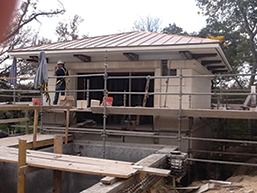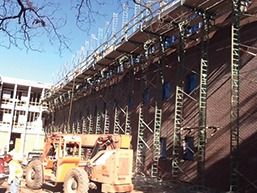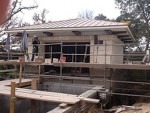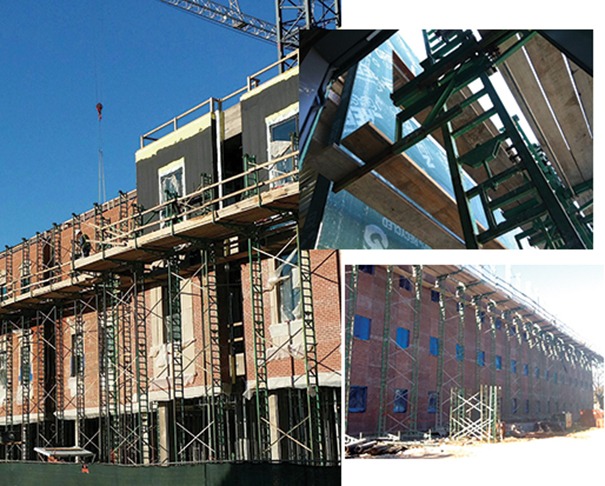February 2015
Fall Protection Safety
No company wants one of its team members to suffer a fall, regardless of the severity. The lengths to which the company will go to accomplish this is another story.
OSHA has a minimum standard. For example, an employee working from a scaffold must have fall protection at a height of 10 feet. Another example: The competent person determines the feasibility of utilizing fall protection for scaffold erectors. We could cite a host of additional minimum standards by OSHA in fall protection. A controlled access zone is necessary for laying masonry on a leading edge without a personal fall arrest system (PFAS) or the overhand bricklaying exception for fall protection when laying a CMU wall – meaning no handrails are required on the side of the scaffold where the wall is being constructed.
In each of these examples, many contractors choose to supersede the minimum requirements for fall protection and do more to protect their workers. Industry standards and best practices are the drivers in this case. Even though OSHA has a 10-foot scaffold fall protection rule, the industry standard is six feet. So, most contractors have the six-foot rule in their written safety policy.

Though the competent scaffold person could, under the OSHA rule, allow the scaffold erectors to forgo the use of fall protection if he deemed it unfeasible, the more safety-conscious employers choose to tie off their erectors, even in less-than-ideal circumstances. It is better to have a PFAS arrest a fall than to have the ground do so. One could set up a limited access zone, wherein only trained and aware workers could work near a leading edge without PFAS, but most go the extra mile and tie their folks off anyway.
The point is to figure out where you want to be, and then make that your rule. Next, re-evaluate the policy by hazard assessments, near misses, injury investigations, continued education and etc. Always have an open mind, and be willing to better protect your team when you see you can.
Changing the culture
One of the biggest obstacles to effective fall protection for workers is the “culture” of safety in the company. What is the culture or the “norm” within a company? What is acceptable, and what is frowned upon? Within your company, how would an employee be viewed if he chose to use fall protection in a given situation? Would he be seen as one trying to “milk” a job by wasting time, slowing production, asking for more equipment than needed and as a worker who really doesn’t fit in?

Or, would he be seen as a good, safety-conscious team member who fits in well with the rest of us, because his priorities are right? These are questions that each person – from the CEO to the field lead man – needs to answer honestly. Top-down belief and commitment are the only way to achieve the safety culture needed. A breakdown anywhere along that chain will result in failure.
Bottom line: Do your people feel empowered to use or ask for fall protection anytime they need or want it? What kind of culture do you have? Do your employees feel pressure to use fall protection, or do they feel pressure not to do so?
You don’t know what you don’t know
Finally, fall protection is complex. One size does not fit all. A multitude of differing scenarios exist, and each of those may have numerous options regarding fall protection. Some will not be as good as others, and it takes a trained, knowledgeable professional to arrive at the right choice. Then, each affected employee must be trained to carry out the plan and/or use the equipment.
OSHA states that training must be given to each employee exposed to a fall hazard by a competent person in the following areas:
- The nature of fall hazards in the area
- Correct procedures in setting up, maintaining and removing a fall protection system
- Use and operation of system
- Role of each person in the system
- Use and limitations of mechanical equipment.
It can be unfair and unwise to strap a crew foreman with the entire responsibility of fall protection. Fall protection situations, regulations and equipment are dynamic, ever changing and advancing. For a company to make the best decisions in this area, a safety professional is needed. It could be performed by the company safety director or an outside safety consultant. In some cases, a fall protection manufacturer could provide training and guidance for using its products.
Safety is a journey. As we learn, we change. Why? It’s because 4,405 U.S. workers lost their lives on the job in 2013. Does anyone want to make that horrific phone call to the mother of a young worker who just fell to his death? And when she asks what happened, what will your answer be?
Zach Everett is corporate safety director of Brazos Masonry Inc. and Legacy Masonry LLC, and MCAA Safety Committee Chairman.

